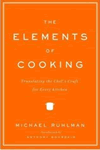The Elements Of Cooking
The introductory chapters of this lively little book are a superb introduction to cooking. What are we trying to do? What tools do we need? What does almost everyone do wrong? These essays, on topics ranging from salt to kitchen equipment to the essential kitchen library, are a wonderful idea.
The bulk of the book is a glossary, a project of which I was skeptical. We don't really care what it's called; we want to know how to do it. (People who are inclined to look stuff up have resources and Larousse, and lots of people won't bother) But Ruhlman seizes the opportunity by preparing dozens of bite-sized essays on topics that range from cauliflower (sadly neglected) to trichinosis (not the concern your mother told you it was). The selection of topics is interesting: cauliflower but no asparagus, sauteuse and tagine but no wok. These aren't casual omissions, I think, but reflect deliberate and interesting selections from the vast menu of possibilities.
What I miss, since so much of the book focuses on the joys of classical sauces, are a table of the most familiar of the classical sauces and their relationships, and also a table of classical ratios. (Ruhlman describes the ratio table in Making of a Chef and I've wanted to see his ratios ever since.) And, while I'm wishing, how about a table of classical potato preparations, so we can remember which one is dauphin and which dauphinoise. Tallyrand's guide to the potato is back — though impossible to find on his site if you don't know how to google it; something like this would make a wonderful appendix.
